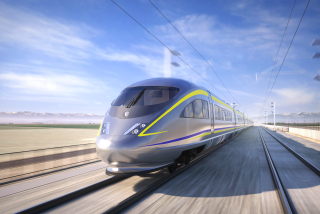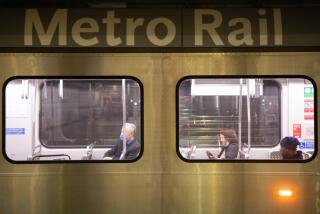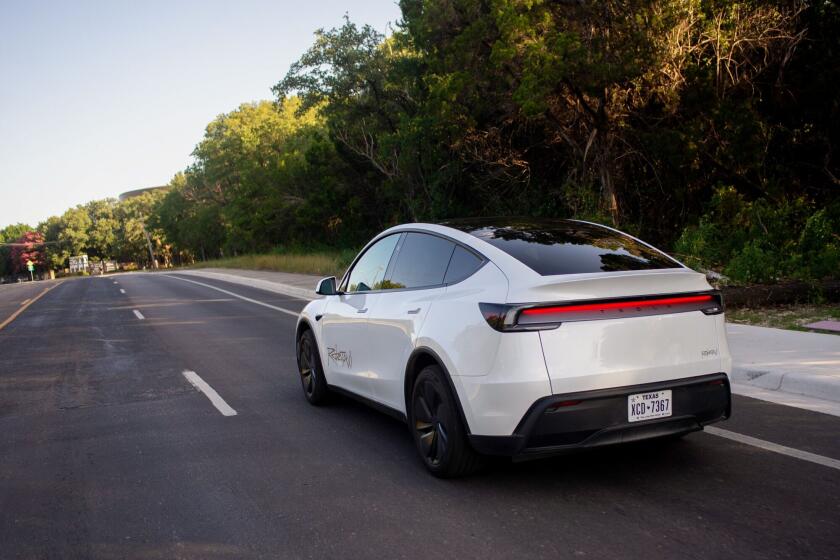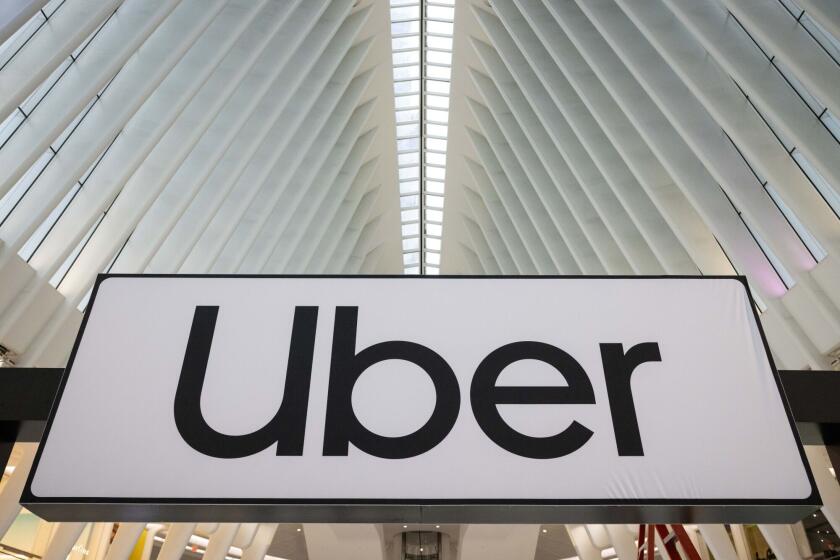House Compromise Clears Way for Metro Rail Funds
- Share via
WASHINGTON — A last-minute compromise in a controversy over the safety of the proposed Los Angeles Metro Rail subway was approved by the House on Wednesday, assuring that funding to begin the $3.3-billion project will be included in a transportation bill expected to be passed by the House today.
After a series of meetings and telephone conferences late Tuesday and early Wednesday by Los Angeles’ major political officeholders, an agreement was struck that would subject the entire 18.6-mile, downtown-to-North Hollywood route to a new safety review.
“It’s a victory . . . a cause for celebration,” said a slightly haggard Nikolas Patsaouras, president of the Southern California Rapid Transit District’s board of directors, who had spent three days scurrying around Capitol Hill to shore up support for the beleaguered project.
The compromise amendment by Reps. Henry A. Waxman (D-Los Angeles) and Julian C. Dixon (D-Los Angeles) requires that a later phase of the subway would be rerouted to avoid the Fairfax District, the scene last March of an explosion of underground methane gas in a clothing store that injured 21 people.
A separate agreement apart from the federal legislation calls for a new review of the hazards of underground gas pockets and annual reports by RTD to Congress on the section from Wilshire Boulevard and Alvarado Street to North Hollywood. City officials also agreed, as part of the settlement, to establish a technical panel that will hold public hearings on the safety of the first 4.4-mile segment of the line under downtown Los Angeles, where high readings of underground methane gas have also been found.
That 10-member panel, whose recommendations would not be binding on the RTD--the builder and operator of the system--would report to the Los Angeles City Council’s Transportation and Traffic Committee headed by Council President Pat Russell. Russell would name eight of the members and Waxman would name two. The report would have to be submitted by the end of the year.
“I think I’ve gotten everything I wanted,” said Waxman, who, after the clothing store explosion in his district, announced that he would attempt to kill the entire project if Metro Rail’s backers did not reexamine the hazards of tunneling through gas pockets.
A longtime supporter of the project, Waxman said: “It was not my objective to keep (the project) from getting funded. My objective was to keep them from being so locked into an idea that they had to claim it to be safe and refused to look at evidence to the contrary.”
The $10.1-billion transportation bill, which if approved as expected today, will go to the Senate for consideration later this month. It would earmark $429 million for the first phase of the subway. That would include $129 million being withheld by the Reagan Administration now and $117 million for fiscal 1986. The 1986 appropriation had been $130 million in an earlier version of the bill but was trimmed Wednesday by the House as part of a $1-billion cut aimed at meeting overall federal budget targets.
First Segment
More important than the appropriations themselves, however, is language included in the bill that would order the federal Urban Mass Transportation Administration to issue full-funding contracts for the first segment of the subway within 30 days of approval by the Congress and the President. The Administration, which is opposed to Metro Rail and other new rail projects as too costly, has caused ground breaking on the subway to be delayed nearly a year by its reluctance to release funds.
This year’s Metro Rail battle in the Senate, where the project continues to enjoy bipartisan support, despite the Administration’s opposition, will be over the amount of next year’s funding, given concerns about the deficit.
“We don’t think it’s a bad project,” said a Republican Senate staff member knowledgeable about transportation issues.
The dispute with Waxman, who chairs a powerful subcommittee that investigates health and environmental safety issues for the House, triggered the major battle this year. After months of behind-the-scenes negotiations to avert a fight that both sides insisted they did not want, issues remained unresolved as the transportation bill made it way to the House floor.
Waxman went public with his objections, hoping to force RTD officials to compromise and agree to reopen the route safety question. In the end, the main stumbling block, which arose to threaten a bloody political floor fight that could have killed the project, was whether the first section of the route under downtown Los Angeles should be restudied.
Available Evidence
RTD officials kept insisting that all of the available evidence indicated that the first stage could be built safely, despite the fact that a substantial portion under the heart of downtown had been designated a “high-hazard” gassy area by its engineering consultants. They argued that if RTD undertook a new study, it would give the federal transit agency another excuse to delay funding and possibly scuttle the whole project.
However, with the review of the first segment non-binding on RTD and conducted independently by the city, RTD officials Wednesday grudgingly went along with the compromise to avoid a floor fight.
“There was reluctance on my part,” Patsaouras said. “I believe we’ve already done all that had to be done.”
Waxman said the compromise satisfied his concerns, because it takes the safety review public and forces a body politically accountable to the voters--Russell’s committee--to review the matter.
Dixon, a leading Metro Rail advocate and Waxman ally who played a central role in the on-and-off attempts at compromise, said a deal appeared unlikely as late as 9 p.m. Tuesday, after a new round of negotiations proved fruitless.
It was not until an hour before the floor fight was to begin that the handshake on a settlement was made. Sources said Los Angeles Mayor Tom Bradley; Russell; Waxman’s close ally, Rep. Howard Berman (D-Los Angeles), and top RTD officials were involved in one way or another in the compromise talks.
‘Great Victory’
Bradley, who was back in Los Angeles Wednesday, called the House vote “a great victory.”
He ridiculed the idea that the subway would never be built.
“Metro Rail is like a cat with nine lives,” Bradley told reporters at a news conference. “People in the media and others have proclaimed it dead at least nine times, and yet today, we had a historic vote in the House of Representatives . . . so we can start construction on Metro Rail.”
He said he has no reservations about declaring the proposed route free of methane gas danger.
“We’re confident about the safety (of Metro Rail). We are as concerned about safety as anybody. We wouldn’t build if we didn’t think it was a safe thing to do. But we’re going to have the experts just confirm what we have contended all along.”
RTD General Manager John A. Dyer, who joined Bradley and Russell at the news conference, said he is confident that those scrutinizing the safety issues “will come to the same conclusion that the system can be built safely and operated safely for 100 years, without any major problems at all.”
No Tunneling
As part of the agreement in Washington, Dyer said no tunneling or subway stations would be allowed in the potentially risky or high-risk methane-gas area that was identified by a Los Angeles city task force.
The risk zone area, Dyer said, is bordered roughly by Rossmore Avenue on the east, just south of Wilshire Boulevard on the south, almost to La Cienega Boulevard on the west and almost to Beverly Boulevard on the north.
Approximately four miles of the line and three stations in that area--at La Brea Avenue and Wilshire, Fairfax Avenue and Wilshire and Fairfax and Beverly--would be eliminated under the compromise.
Dyer said the new study to look at alternate routes would take about a year and would be funded partly by the federal government and partly by state and local dollars. However, Dyer told reporters that “in my view, we will end up with a route that is high ridership or higher ridership and less costly.”
The construction, though, is still a couple of years away, Dyer said.
He insisted that the need to review the route after the first 4.4 miles and come up with another route will not slow down construction of Metro Rail. Dyer also said the panel that will be convened to study the methane gas hazard in the route’s first four miles in the downtown area should conclude its work by Jan. 1 and the RTD should be able to begin construction of the first leg around that time.
Less Concentrated
Dyer conceded that the RTD would not be bound by the findings of the panel, but he said the methane gas present in the downtown area is much less concentrated than in the Fairfax-Beverly area and does not present any dangers.
“We are very confident that they (panel members) will not come up with anything,” he said.
Russell, who also lauded the compromise, said she would name a number of experts to the panel (of the eight slots allotted to her) but had no one in mind yet. The councilwoman said she will rely on members of the council’s Transportation and Traffic Committee to help her.
More to Read
Sign up for Essential California
The most important California stories and recommendations in your inbox every morning.
You may occasionally receive promotional content from the Los Angeles Times.













